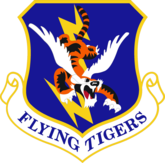23rd Fighter Group
 | |
|---|---|
 23rd
Fighter Group A-10C Thunderbolt II attached to the 332nd Air Expeditionary Wing takes off from a forward-deployed location during Operation Iraqi Freedom. | |
| Active | 1942–1946, 1946–1949, 1951–1952, 1955–1959, 1991–1997, 2006–present |
| Country | United States |
| Branch | |
| Role | Close Air Support |
| Size | 900 personnel 48 A-10C aircraft |
| Garrison/HQ | Moody Air Force Base, Georgia |
| Nickname(s) | Flying Tigers |
| Mascot(s) | Tiger with Wings |
| Engagements | World War II Iraqi no-fly zones conflict Operation Uphold Democracy War on terror Iraq War |
| Decorations | Distinguished Unit Citation |
| Commanders | |
| Current commander | Colonel Nicholas DiCapua[1] |
| Notable commanders | Col. Robert L. Scott General Bruce K. Holloway Brig, Gen. David Lee "Tex" Hill Col. Edward F. Rector |
| Insignia | |
| 23rd Wing emblem (approved 24 January 1957)[2] |  |
The 23rd Fighter Group (23 FG) is a United States Air Force unit. It is assigned to the 23rd Wing and stationed at Moody Air Force Base, Georgia.
The 23rd Fighter Group was established in World War II as the 23rd Pursuit Group of the United States Army Air Forces (USAAF).[3] Redesignated the 23rd Fighter Group before its activation, the group was formed in China on 4 July 1942,[3] as a component of the China Air Task Force and received a small cadre of volunteer personnel from the simultaneously disbanded 1st American Volunteer Group (AVG) – the "Flying Tigers"[3] of the Chinese Air Force.
To carry on the traditions and commemorate the history of the AVG, aircraft of the USAF 23rd Fighter Group carry the same "Shark Teeth" nose art of the AVG's Curtiss P-40 Warhawks, along with the "FT" (Flying Tiger) tail code. The 23rd Fighter Group's aircraft are the only United States Air Force aircraft currently authorized to carry this distinctive and historical aircraft marking.
- ^ "23rd FG changes hands". Moody Air Force Base. 21 July 2023. Retrieved 11 February 2024.
- ^ Haulman, Daniel L. (9 April 2012). "Factsheet 23 Fighter Wing (ACC)". Air Force Historical Research Agency. Retrieved 28 July 2012.
- ^ a b c Maurer, Combat Units, p. 72